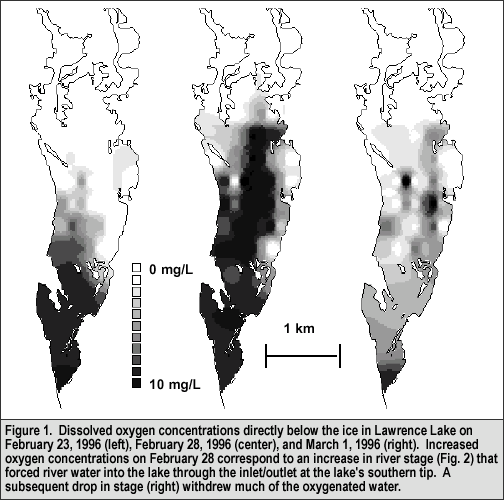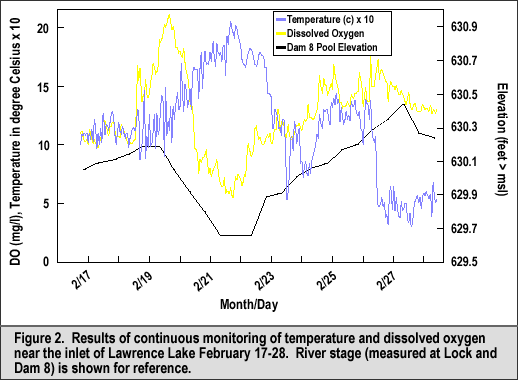|
PSR 96-02 June 1996 Minor Water Level Changes Important to Winter Habitat in Off-Channel Areas of the Upper Mississippi Riverby Dave Soballe, James T. Rogala and Jim Fischer |
|
Suitable habitat for some species of overwintering fish in the Upper Mississippi River is rare and could potentially limit their populations. Off-channel areas that provide winter refugia for many species must have adequate dissolved oxygen (greater than about 4 mg/L), low current velocities (less than about 1 cm/ sec), and relatively warm water temperatures (greater than 1o C). Water movement (or lack of movement) can play a central role in establishing and maintaining suitable habitat conditions under the ice, and thus the connection between an off-channel area and the main river can be critical. We used a continuous monitor and spatially intensive sampling over a 40-day period (February 5–March 11, 1996) to investigate the effects of water movement on under-ice conditions in a large (3-km 2 ) embayment (Lawrence Lake) in Pool 8 of the Upper Mississippi River. Because there is only one point of connection between the main channel and this embayment, changes in river level control the movement of water in and out of the lake. We believe that many off-channel areas with only a single connection to the river will exhibit similar behavior. 
The results show that a relatively small (0.2 m or 0.6 ft) increase in river stage over the course of 2–3 days causes a major inflow of water from the main channel and effectively reoxygenates the near-surface waters of this embayment (Figs. 1 and 2). The introduction of cold, main-channel water into the embayment also lowers the near-surface water tem perature from 2–3o C to below 1o C. The warmer resident water near the bottom of the embayment (not shown here) remains relatively undisturbed. A subsequent drop in river stage withdraws some heat and much of the introduced oxygen from the surface of the embayment, but acceptable oxygen concentrations (greater than 4 mg/ L) persist across a large portion of the backwater at the end of the circulation cycle (Fig. 1). This tide-like water move ment has a slight negative effect on the lake’s thermal regime and creates significant fluctuations in water velocity and oxygen concentration near the lake’s inlet. The net effect on overwintering sport fish (bass, crappie, bluegill) must be carefully evaluated, but it is clear that minor fluctuations in water level can dramatically influence habitat conditions in off-channel areas of the Upper Mississippi River System.  |
|
|
|
This report is a product of the Long Term Resource Monitoring Program for the Upper Mississippi River System. For further information, contact David M. Soballe or James
T. Rogala Jim Fischer
Project Status Reports (PSRs) are preliminary documents whose purpose is to provide information on scientific activities. Because PSRs are only subject to internal peer review, they may not be cited. Use of trade names does not imply U.S. Government endorsement of commercial products. All Project Status Reports are accessible through the Upper Midwest Environmental Sciences Center’s website at http://umesc.usgs.gov/reports_publications/psrs/umesc_psr.html |
Page Last Modified: April 17, 2018

